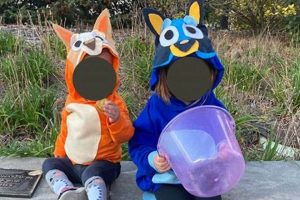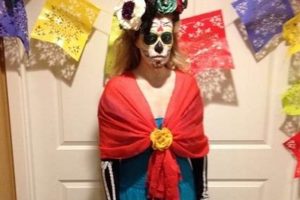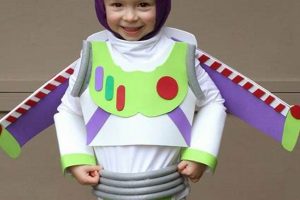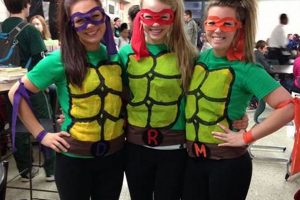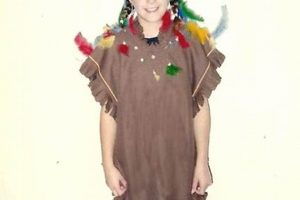Creating a do-it-yourself rendition of the iconic horror character’s attire involves replicating key components. This includes the bladed glove, striped sweater, and disfigured mask or makeup application. The creation often relies on accessible materials such as readily available clothing items, craft supplies, and makeup techniques.
The act of assembling such a representation provides an opportunity for creative expression and resourcefulness. Furthermore, this approach frequently results in a more personalized and cost-effective alternative to purchasing a pre-made version. The character’s cultural impact, stemming from its popularization in film, contributes to the ongoing interest in replicating the distinctive visual elements.
The following sections will delve into detailed instructions for constructing individual aspects of this ensemble, offering guidance on material selection, crafting techniques, and application methods to achieve a recognizable and effective result.
Guidance for Crafting a Recognizable Character Representation
Achieving a compelling recreation of the character’s appearance requires careful attention to detail and resourcefulness in material selection and application.
Tip 1: Fabric Selection for the Sweater: Opt for a tightly knit fabric for the striped sweater, ensuring durability and a visually accurate texture. Consider a blend of acrylic and cotton for comfort and ease of dyeing to achieve the correct color variations. Avoid excessively stretchy materials which may distort the stripes when worn.
Tip 2: Glove Construction: Prioritize safety when constructing the bladed glove. Utilize a sturdy base, such as a leather work glove, and attach the blades securely. Dull the edges of the blades slightly to minimize potential hazards, while still maintaining the visual impact. Consider using metallic-painted craft foam as a safer alternative to metal blades.
Tip 3: Makeup Application: Research reference images thoroughly before applying makeup to replicate the character’s disfigured appearance. Employ layering techniques with liquid latex and professional-grade scar wax to create realistic textures. Utilize shading and highlighting to emphasize the contours and create depth. Seal the makeup with a setting spray to prolong its wear and prevent smudging.
Tip 4: Hat Acquisition or Modification: The character’s fedora is a crucial element. If acquiring a pre-made hat, ensure it is appropriately distressed to match the character’s worn appearance. Techniques include brushing with sandpaper, applying diluted brown paint, and strategically creating tears or holes. If modifying an existing hat, choose one made of felt or a similar pliable material.
Tip 5: Ensuring Accurate Proportions: Pay close attention to the proportions of each component relative to the overall ensemble. The length of the blades, the width of the sweater stripes, and the size of the hat should be consistent with the character’s established appearance. Utilizing reference images throughout the creation process is essential for maintaining accuracy.
Tip 6: Prioritize Comfort: While accuracy is important, prioritize comfort, especially for prolonged wear. The sweater should be breathable, the glove should allow for some degree of hand movement, and the makeup should not cause excessive irritation. Conduct a test run of the entire ensemble prior to wearing it for an extended period.
Achieving a successful recreation involves meticulous planning, careful execution, and a commitment to accurately portraying the iconic character’s distinctive features.
The following sections will explore advanced techniques and alternative material choices to further enhance the quality and realism of the character depiction.
1. Bladed Glove Construction
The bladed glove is arguably the most iconic element in a do-it-yourself rendition of the horror character. Its construction, therefore, directly influences the overall success and recognizability of the complete representation. A poorly constructed glove, lacking in durability or visual accuracy, detracts significantly from the impact of the entire attire. For example, blades that are improperly secured or made from flimsy materials will compromise the intended effect. This single component serves as a visual shorthand for the character, instantly communicating its identity to viewers. Its presence is integral; its absence or poor execution results in a less convincing imitation.
Detailed attention to the crafting process is paramount. The choice of materials, the method of blade attachment, and the overall aesthetic design are all crucial considerations. Safety is also a significant factor; the construction process must prioritize the well-being of the creator and anyone who might come into contact with the finished product. A responsible approach might involve using dulled blades or substituting them with safer alternatives made from materials like painted craft foam or plastic. Failure to adequately address these aspects can not only diminish the visual appeal but also introduce potential hazards. Real-world examples demonstrate a spectrum of outcomes, from meticulously crafted gloves that closely resemble the cinematic prop to less successful attempts that lack detail and realism.
In summary, bladed glove construction is a foundational aspect of achieving a convincing self-made portrayal. A meticulous and safe approach is necessary to create a glove that is both visually effective and poses minimal risk. The challenges associated with replicating this element highlight the importance of planning, resourcefulness, and attention to detail, ultimately shaping the effectiveness of the entire endeavor.
2. Striped Sweater Replication
The striped sweater is a defining element, readily associated with the character, and its accurate replication is crucial for a successful representation.
- Color Accuracy
The sweater’s distinctive color palette typically a combination of deep red and olive green must be accurately reproduced. Deviation from this established color scheme diminishes recognition. Improper hues can lead to the costume being perceived as a generic horror ensemble rather than a specific character imitation. Utilizing dye techniques to match the intended colors is paramount. Examples of successful replications prioritize precise color matching, while failures often stem from using readily available but inaccurate color alternatives.
- Stripe Pattern Fidelity
The arrangement and width of the stripes are equally important. Inconsistent spacing or variations in stripe width compromise the overall visual impact. The character’s sweater possesses a specific, recognizable pattern that must be meticulously followed. Correctly replicating this pattern ens
ures immediate visual association. Examples of high-quality replications demonstrate precise adherence to the stripe pattern, while less successful versions exhibit inaccuracies in spacing or stripe width, lessening the overall effect. - Fabric Texture and Weight
The choice of fabric influences both the appearance and comfort of the finished sweater. A coarse, loosely knit fabric will not accurately reflect the character’s on-screen appearance. Heavier-weight fabrics contribute to a more authentic draping and overall presence. Opting for a suitable fabric type significantly enhances the replication’s visual fidelity. Successful examples utilize fabrics that mimic the look and feel of the original sweater, while less effective replications may employ materials that are too thin, shiny, or otherwise inappropriate.
- Distressing and Wear
The character’s sweater often exhibits signs of wear and damage, reflecting its history and contributing to its overall aesthetic. Replicating these details such as tears, holes, and faded areas adds authenticity to the representation. Intentional distressing techniques can enhance the realism of the sweater. High-quality examples incorporate realistic distressing elements, while less convincing replications may appear too pristine or artificially aged.
The meticulous replication of the striped sweater directly impacts the overall effectiveness. Color accuracy, stripe pattern fidelity, fabric choice, and distressing techniques all contribute to a successful character representation. Inaccurate or poorly executed elements diminish visual impact and recognizability.
3. Facial Disfigurement Application
Facial disfigurement application is integral to the creation of an effective representation. This aspect directly contributes to the character’s horrifying aesthetic and is thus essential for achieving recognizability. The absence of accurately replicated facial disfigurement significantly diminishes the overall impact of the do-it-yourself rendition, regardless of the quality of other costume elements. A successful example might involve the use of liquid latex, scar wax, and professional-grade makeup to create realistic burns and textures, mirroring the character’s on-screen appearance. In contrast, a poorly executed application, such as using simple face paint without attention to depth or texture, would result in a less convincing and potentially comical outcome. Cause-and-effect dictates that realistic application leads to a compelling portrayal, while insufficient effort results in a failed imitation.
The practical significance of understanding and mastering facial disfigurement application lies in its ability to elevate the entire do-it-yourself creation. Techniques range from simple methods suitable for beginners to advanced approaches requiring specialized materials and skills. For instance, a beginner might utilize readily available theatrical makeup to create basic scars and burns, while an experienced individual could employ prosthetics and airbrushing to achieve a hyper-realistic effect. The chosen method dictates the level of realism attainable, and thus, the ultimate effectiveness of the disguise. Instructionals detailing techniques are readily available and provide practical guidance for those seeking to improve their skills. These guides often emphasize layering, shading, and blending to create depth and dimension, crucial for replicating the character’s grotesque features.
In summary, facial disfigurement application is not merely an optional accessory, but a fundamental component in completing. Its successful execution separates a passable imitation from a truly compelling representation. The challenges lie in mastering the necessary techniques and utilizing appropriate materials, but the resulting enhancement of realism justifies the effort. The ability to convincingly replicate the facial disfigurement remains a key determinant in the overall effectiveness and impact of the finished product, linking directly to the perceived success of the do-it-yourself project.
4. Hat Distressing Techniques
The condition of the hat significantly contributes to the overall aesthetic of a do-it-yourself representation. Authentic representations often feature a fedora exhibiting signs of wear, damage, and age. Therefore, hat distressing techniques are crucial for achieving visual accuracy. A pristine, unaltered hat detracts from the character’s established appearance and diminishes the credibility of the overall rendition. Cause and effect dictate that employing appropriate distressing methods results in a more convincing portrayal, while neglecting this aspect compromises the desired outcome. For example, sanding, burning, and staining can create a believable aged appearance. The character’s distinctive hat is not merely an accessory; it is an integral part of his visual identity, and its accurately weathered state is paramount.
Various methods can effectively simulate wear and tear. Sandpaper can create subtle abrasions, mimicking years of use. Carefully applied heat, such as from a lighter or heat gun, can create burn marks and textural distortions. Staining with diluted paints or inks can simulate dirt, grime, and fading. Specific techniques depend on the hat’s material. Felt hats respond well to sanding and steam shaping, while straw hats may require different approaches. Real-world examples include using diluted coffee to stain a felt hat, creating a realistic aged effect, or using a wire brush to roughen the brim of a straw hat, simulating damage. Understanding these methods allows individuals to tailor the distressing process to achieve the desired level of authenticity.
In summary, hat distressing techniques are indispensable for creating an authentic representation. Employing these techniques elevates the overall realism and visual impact. The challenge lies in achieving a believable level of wear without overdoing it or compromising the hat’s structure. Mastering these techniques enhances the credibility of the entire do-it-yourself project, linking directly to the effectiveness of the character depiction. The degree to which the hat appears worn and weathered profoundly impacts the realism and recognizability.
5. Material Cost Efficiency
Material cost efficiency is a significant consideration in the creation of a do-it-yourself representation. The economic advantage inherent in utilizing existing resources or inexpensive alternatives contributes directly to the appeal of self-assembly. The principle of cause and effect dictates that minimizing material expenses results in a more accessible and financially viable project. High-budget, professionally manufactured costumes contrast sharply with the cost-effective nature of self-made attire, making the latter an attractive option for individuals operating with budgetary constraints. The importance of material cost efficiency, therefore, cannot be understated.
Real-world examples illustrate a range of approaches to achieving cost savings. Utilizing thrift store finds for the sweater component, modifying existing gloves for the bladed hand, and employing rea
dily available makeup supplies all contribute to reducing overall expenditures. Some individuals may opt to create blades from cardboard or craft foam instead of purchasing metal alternatives, further minimizing material costs. Practical application of this understanding involves strategic planning and resourcefulness in identifying affordable alternatives to commercially available components. This may include repurposing discarded items or sourcing materials from discount retailers. The ability to effectively manage material costs directly correlates with the accessibility and feasibility of the do-it-yourself project.
In summary, material cost efficiency is a key driver in the creation of self-assembled attire. Strategic resourcefulness and the selection of affordable alternatives can significantly reduce the overall financial investment. While accuracy and realism are important considerations, the ability to achieve a recognizable representation without incurring substantial costs enhances the accessibility and appeal of the project. The challenge lies in balancing cost savings with visual fidelity, ensuring that the cost-efficient approach does not compromise the overall effectiveness of the character depiction. The goal is to create an acceptable outfit while paying less to be more economic and resourceful.
Frequently Asked Questions
This section addresses common inquiries regarding the creation of a self-assembled representation of the iconic character.
Question 1: What are the essential components required for a credible Freddy Krueger DIY costume?
The core elements encompass a striped sweater (typically red and green), a bladed glove, a fedora hat, and makeup or a mask to simulate the character’s facial disfigurement. Each component contributes significantly to the overall recognizability of the representation.
Question 2: Is it necessary to use real metal for the bladed glove?
The use of real metal is not essential and is, in fact, discouraged due to safety concerns. Alternatives such as craft foam, plastic, or rubber can be used and painted to achieve a similar visual effect without posing a hazard.
Question 3: How can the striped sweater be accurately replicated?
The striped sweater can be replicated by either purchasing a suitable sweater and dyeing it or by sewing a sweater from scratch using fabric of the appropriate colors. Attention should be paid to the accurate width and spacing of the stripes.
Question 4: What are the safest and most effective methods for replicating the character’s facial disfigurement?
Liquid latex, scar wax, and professional-grade makeup are commonly used to create realistic burns and scars. Tutorials and reference images can provide guidance on proper application techniques. Thoroughly testing any materials on a small area of skin prior to full application is recommended to avoid allergic reactions.
Question 5: How can a fedora hat be effectively distressed to match the character’s appearance?
Distressing techniques include sanding the hat with sandpaper, applying diluted paint or stain, and strategically creating small tears or holes. The goal is to simulate wear and age without compromising the hat’s structural integrity.
Question 6: What are the most cost-effective strategies for assembling a convincing representation?
Cost-effective strategies include utilizing thrift store finds, repurposing existing materials, and opting for affordable alternatives to professional-grade supplies. Creative problem-solving and resourcefulness are essential for minimizing overall expenses.
Successfully assembling a convincing representation hinges on careful attention to detail and a commitment to safety. Resourcefulness and creative problem-solving are valuable assets in achieving a recognizable and effective Freddy Krueger DIY costume.
The subsequent section will provide a comprehensive guide to further enhance your creation, along with potential sources for inspiration and material acquisition.
Concluding the Freddy Krueger DIY Costume Endeavor
This exploration has detailed the essential elements and techniques necessary for creating a recognizable and impactful rendition. The effective rendering of the bladed glove, striped sweater, facial disfigurement, and hat, coupled with mindful attention to material cost efficiency, define the success of any attempt. The information presented serves as a guide for achieving a credible and visually compelling result.
The construction of a “freddy krueger diy costume” demands both meticulous planning and diligent execution. The resources provided offer a foundation for realizing a distinctive and individualized interpretation of the iconic character. Continuing to refine acquired skills and exploring available resources will yield increasingly impressive and authentic results. Such dedication ensures that any final assembly not only pays homage to the original character, but stands as a testament to the skill and ingenuity of its creator.


